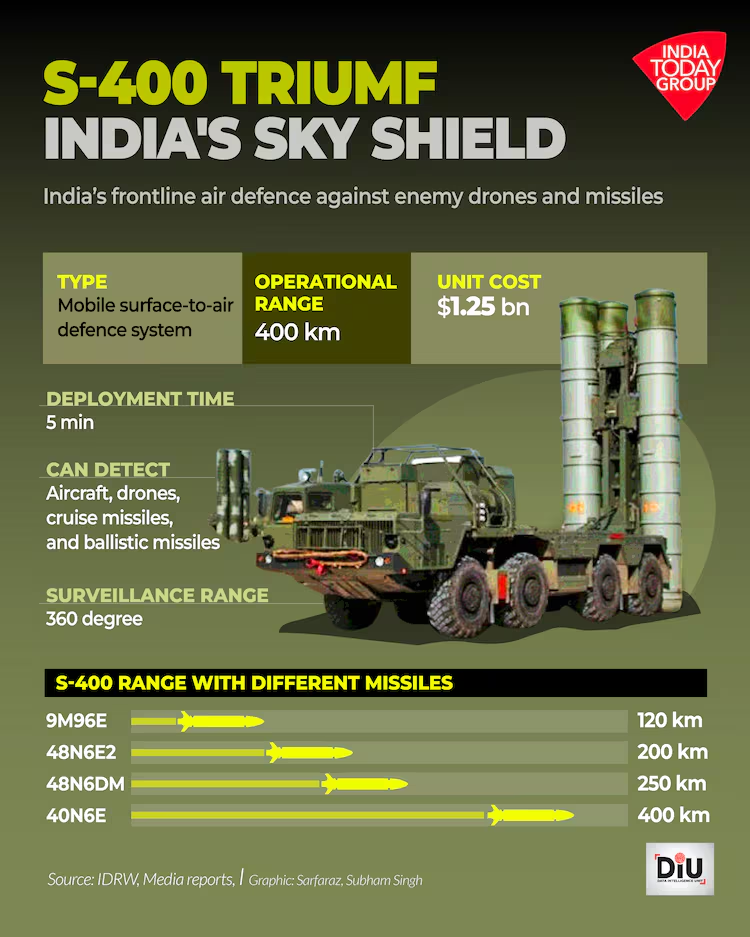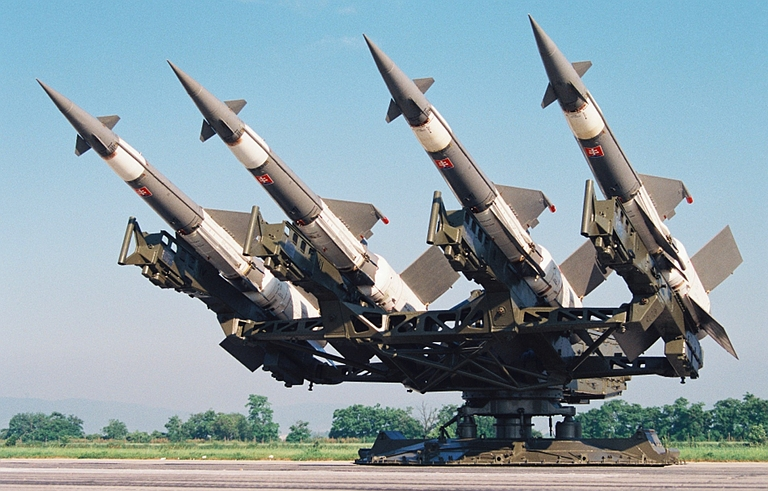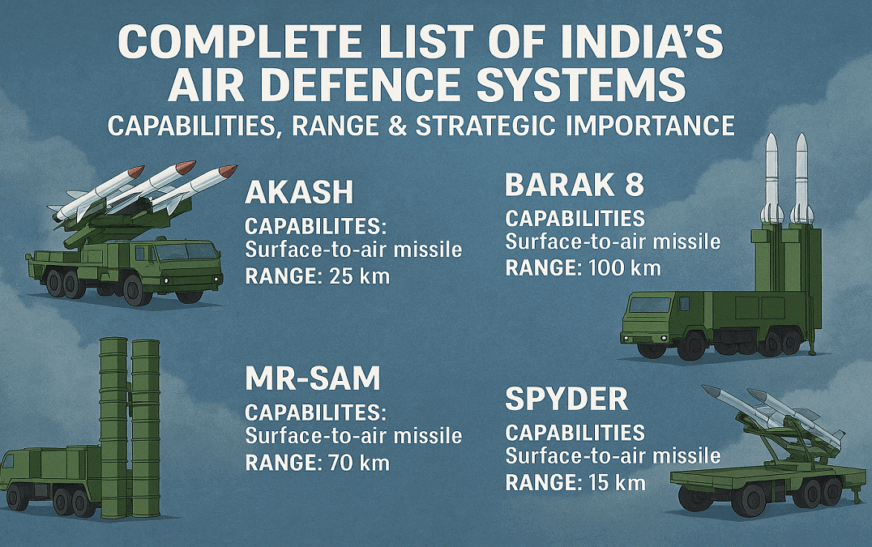In a Football Game—you have defense, and offence(Forwards). Similarly—in kinetic war—you primarily fight with two components: Offence, and Défense. We will be discussing India’s Air Defense System here.
How India’s Layered Air Defense System Works is explained Step-by-Step below:
Early Detection & Tracking is the key of this game.
Radar systems like Swathi (Made in India), and satellites with AWACS detect threats early. And accordingly Air Défense System is activated. Otherwise also—system are kept in ‘ALERT’ state. And some system are equipped with built in RADAR.
The IAF operates three Israeli Phalcon AWACS (offering 360-degree coverage with a 400 km range) and three Netra Mk1 systems, while Pakistan has 11 AEW&C aircraft and China over 30, according to Swarajya Magazine (February 13, 2024)
A. First Layer: MANPADS & L/70 Guns: –(INDIA)
These are Short-range, low-cost, but effective system.
MANPADS (shoulder-fired) – Cost: ₹15–30 lakh.

MANPADS (Man-Portable Air Défense Systems) are short-range, lightweight, surface-to-air missiles designed to be fired by individuals or small groups to engage aircraft and helicopters. They are particularly effective against low-flying targets and are often used to defend troops from aerial attacks. MANPADS typically have a range of 8 kilometres and can engage targets up to altitudes of 4.5 km.
They are particularly effective against low-flying aircraft, helicopters, and even some cruise missiles.
MANPADS utilize different guidance systems, including infrared homing (like the FIM-92 Stinger) and beam-riding (like the RBS 70).
Some MANPADS, like the MISTRAL, are fire-and-forget, meaning the operator only needs to target the aircraft and fire, with the missile taking over from there.
MANPADS have a significant impact on military operations, providing a cost-effective and readily deployable air Défense option. They are particularly important in situations where more advanced air Défense systems may not be available or feasible.
The Very Short Range Air Defence System, or VSHORADS, is a latest man-portable air-Défense system (MANPADS) developed by DRDO.
L/70 Anti-Aircraft Guns – Reliable and rapid-fire option.
The Bofors 40 mm Automatic Gun L/70, (Bofors 40 mm/70, Bofors 40/70 and the like), is a multi-purpose autocannon developed by the Swedish arms manufacturer AB Bofors. It was extensively used and have won us the Kargil war. I picked up this information while I visited a front line army post at Kargil, in the year-2016.

It is deployed for Small Drones & Low-Flying Threats.
B. Second Layer: Akash, Akash-NG, QRSAM (Iron Dome) — INDIA
Akash DIR & NG (Indigenous) – Cost: ₹25–35 crore/unit
“Akash” is a medium-range[ mobile surface-to-air missile (SAM) system developed by the Defence Research and Development Organisation (DRDO). The Army and the Air Force variants of the missile system are produced by Bharat Dynamics Limited (BDL) and Bharat Electronics Limited (BEL). Surveillance and fire control radar, Tactical Command and Control Center and missile launcher are developed by BEL, Tata Advanced Systems Limited and Larsen & Toubro. The Akash missile system can target aircraft up to 45 km away. It has the capability to neutralise aerial targets like Fighter Jets, Cruise Missiles And Air-To-Surface Missiles. It is in operational service with the Indian Army and the Indian Air Force.
It can handle Swarm Drones also.
100% kill-rate is reported in current conflict with Pakistan.
These are India’s workhorse –and are in export-ready state.
C. Third Layer: Barak-8 (INDIA—ISRAEL), MR-SAM (INDIA-ISRAEL)
Developed jointly by India’s Defense Research and Development Organisation (DRDO) and Israel Aerospace Industries (IAI), the Barak-8 missile system is an all-weather Long-Range Surface-To-Air Missile (LR-SAM). Barak literally means ‘Lightning’ in Hebrew. It was christened by the Israel Aerospace Industries (IAI).
The Barak-8 is designed to defend against any type of airborne threat, including Aircraft, Helicopters, Anti-Ship Missiles, UAVS, Ballistic Missiles, Cruise Missiles, And Combat Jets. The Barak-8 operates alongside other advanced systems like the S-400 and Akash missiles. It has a range of 150 km.
The Barak-8 system boasts both land and naval variants, ensuring comprehensive protection for the Indian Air Force, Army, and Navy. Since ‘Operation Sindoor’ is an integrated mission of the tri-services, Barak-8 has become an invaluable defence system for India.
Its advanced radar, command and control, and mobile launcher systems enable rapid detection and interception of high-speed threats, even at long ranges and varying altitudes.
The MRSAM (Medium Range Surface-to-Air Missile) is a medium-range air Défense system developed jointly by India’s DRDO and Israel Aerospace Industries (IAI). It is a mobile, vertically launched, supersonic missile designed to neutralize various aerial threats, including Aircraft, Helicopters, Cruise Missiles, And Other Guided Weapons. It is a modification on BARAK—8. The MR–SAM system is a critical component of India’s layered air Défense, providing protection for both ground assets and warships.
They have expanding deployment across all critical zones. They can target up to 70 km.
D. 4th & Final Layer: S-400 (RUSSIA)
Strategic, most high-value defence system as on day India deployed. Cost: ₹1,200 crore per battery.
The S-400 air defense system is one of the world’s most advanced long-range surface-to-air missile (SAM) systems, developed by Russia’s Almaz Central Design Bureau. It is named after Lord Vishnu’s ‘Sudarshan Chakra’ because of its swift and precision working on Target…
Speed: 17,000 km/h (approximately Mach 14)
Range: Min.120- Max. 600 km
Features: Prominent for its advanced radars, long-range missiles, high mobility, adaptability, flexibility, and networking capabilities.
· The S-400 can operate across a wide altitude range, from as low as 10m up to 30 km.
· The S-400 can operate across a wide altitude range, from as low as 10m up to 30 km.
It is only used when absolutely necessary. In this conflict, India has used once only—Probably to take down ICBM ‘SHAHEEN’, which can carry Nuclear Warheads. And it was successful. Shaheen was intercepted near SIRSA –But Pakistan didn’t couple NWH to that.
And after that India decided to take down 11 AIR BASES of Pakistan. We have achieved a sum-total of 20% destruction, and near in-operability of those bases in short term.
It is Capable of neutralizing Stealth Aircraft, Ballistic Missiles.
Deployed in Delhi, Punjab & Northeast.
Why 100% Success So Far?
Layered response: Each threat is matched with a cost-effective Interceptor/Destroying System.
Indigenized technology dominance: reduces load on S-400, allowing continuous protection
Kinetic + electronic warfare combination working in tandem ensures zero penetration.
Export Ready HARDWARE:
Akash, QRSAM, and Swathi radars are already in demand (Vietnam, Philippines, Armenia)
After the Pakistan conflict, global orders are expected to surge. Our Made in India product is low cost, yet 100% effective, and Battle tested.
Disclaimer: –This BLOG is published for spreading awareness against mis-information campaign by persons/groups with vested interest.
Sources:– I collected informations from following sources listed. But mostly they are available in public domain also, when I tried to cross-check..
NEWSPAPERS:–HT, IE, MINT.
JOURNALS,MAGAZINES:-
Swarajya Magazine
Defence and Security Alert –
Indian Air Force Journal –
Indian Army Journal –
Indian Defence Technol
IMAGES: GOOGLE.








